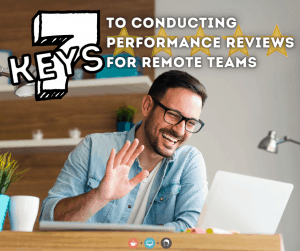How to Approach Regular Performance Reviews in Remote Work Scenarios
Performance reviews are an essential part of any job, providing employees with valuable feedback on their work performance and giving employers the opportunity to assess and recognize their employees’ contributions. In person, reviews are normally conducted one-on-one with live examples of jobs well done and areas for improvement. However, what does that look like in a remote work scenario?
Understanding Regular Performance Reviews in Remote Work
Although these are through a screen, remote performance reviews are designed to mimic the dynamics of in-person reviews, ensuring that the objectives of aligning performance with organizational goals, addressing challenges, and setting a trajectory for future growth are met. These reviews are adapted to the digital environment, typically facilitated through virtual platforms like video conferencing or telephone calls to bridge the physical gap inherent in remote settings.
The essence of these sessions is to foster a mutual understanding of job expectations, identify any discrepancies in performance, and celebrate the accomplishments of remote employees. This process is integral in maintaining open lines of communication and reinforcing the sense of belonging and contribution among remote workers. Through regular interactions, a continuous feedback loop is established, allowing for real-time adjustments and recognition, which is vital for the motivation and productivity of remote employees.
What Job Seekers Should Expect During Performance Reviews
During performance reviews, employees should be prepared to engage in thorough discussions about their contributions and areas requiring enhancement. The dialogue will likely encompass both the technical aspects of their job performance and the softer skills, such as communication and teamwork. Expectations will be set for future performance, with a particular focus on how one can further align with the organization’s goals and culture remotely.
It is crucial for individuals to approach these reviews with a mindset geared toward growth, ready to articulate their achievements and receptive to constructive criticism. Equally, there will be an opportunity to express career aspirations and seek advice on professional development. This is a chance to clarify any uncertainties about job responsibilities or to request resources that could aid in job performance improvement.
Remember, this is not to criticize your work in a harsh manner. This is just some feedback so that you can improve. This is also your chance to share your voice about any inefficiencies in the company’s procedures — a performance review goes both ways.
Preparing for Your Review: Tips for Remote Employees
Begin preparing by cataloging your achievements, noting how they align with the team’s objectives and any innovative solutions you’ve introduced to overcome remote work challenges. Equally important is identifying areas where you seek improvement or additional support. Consider setting realistic and measurable goals for your professional growth and how you intend to achieve them. Compile any questions you have about your role, feedback on the remote working conditions, or resources you feel could enhance your performance.
It is best to prepare ahead of time so that you can approach the review in an orderly manner to ensure all your points are addressed.
What Employers Need to Consider When Conducting Remote Reviews
When organizing performance reviews for remote teams, employers must prioritize structure, empathy, and clarity; this is not about ambushing employees to see how they react — performance reviews are to help both employer and employee grow so that the business grows. The foundation of an effective review begins with setting a precise agenda and sharing it in advance with employees to foster a prepared and open dialogue. Utilizing reliable digital tools ensures a seamless communication experience, while personal touches, such as beginning the conversation with informal catch-up, can help in bridging the emotional distance. It’s vital to focus on specific achievements and areas for improvement, supported by examples, to make the feedback tangible and actionable. Emphasizing future development and opportunities rather than solely past performance encourages growth and motivation.
Employers should actively listen, offering a platform for employees to voice their experiences, challenges, and aspirations within the remote work context. This includes understanding their home work environment and any external factors that may affect their performance. Establishing a follow-up plan to revisit goals and provide ongoing support underscores the commitment to employee growth beyond the review itself.
The Impact of Regular Performance Reviews on Remote Work Success
The effectiveness of regular performance reviews extends far beyond mere assessments in the realm of remote work. They serve as a vital mechanism for reinforcing company values, goals, and expectations, while simultaneously catering to the individual growth needs of remote employees. Such reviews are instrumental in fostering a culture where feedback is not only anticipated but valued as a tool for personal and professional development. Through these structured interactions, employers and employees collaboratively pave the way for sustained growth and achievement in a remote setting.

